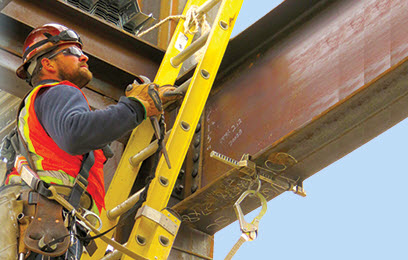This week is the U.S. Occupational Safety and Health Administration’s (OSHA) fall safety stand-down, when OSHA and its partner organizations encourage employers nationwide to take time out of the workday to address fall hazards in their workplaces. Different fall hazards require different solutions, so OSHA recommends that employers begin by determining what types of fall hazards exist in the workplace.
 |
Kick off your fall prevention activities with a workplace survey that shows you where your workers are at risk.
Identifying Fall Hazards
Conduct a workplace walk-around, and look for:
Ladders. If your workers are using ladders, you’ll need more information to fully characterize the hazards they may be exposed to, including:
- What tasks are workers performing? Different ladders are appropriate for different job tasks.
- Are workers using fixed or portable ladders?
- Are they using stepladders, straight ladders, or extension ladders?
- Are they potentially exposed to electrical hazards? If so, are their ladders potentially conductive?
Roofs. Workers on roofs are exposed to falls:
- From unprotected or inadequately protected edges. For example, on flat roofs, a low parapet wall may not be adequate protection, and on sloped roofs, slide guards are not adequate fall protection.
- Through roof openings and holes. Workers may not realize that a roof opening that is covered, for example, by a skylight, is not actually safe. Skylight covers are not designed to hold the weight of a worker.
- Through fragile roof surfaces. If the underlying roof surface is rotten or unstable, workers may be exposed to a fall hazard they cannot easily identify.
Scaffolds. Scaffolds pose preventable fall hazards to workers if they are not:
- Equipped with safe means of access;
- Fully planked with safe lumber;
- Plumb and level; or
- Equipped with full guardrails.
Stairs. Stairs in finished buildings are typically in compliance with safety codes; however, stairs on construction sites may pose fall hazards to workers. Look for:
- Adequate landings. Landings should be at least 30 inches (in.) deep and 22 in. wide, and there should be a landing every 12 feet (ft) or less of vertical rise.
- Safe angles. Stairs that are less than 30 degrees or that are more than 50 degrees from horizontal are unsafe.
- Uniform rise and run. If the riser height or stair tread depth are not uniform, workers are more likely to trip.
- Space around doors and gates. Landings must have adequate clearance (at least 20 in.) around swinging doors and gates that open directly onto stairs.
- Dangerous projections. Protruding nails, splinters, and other projecting items can pose a tripping hazard as well as non-fall-related hazards.
- Slippery conditions. Stairways exposed to weather may be slippery.
- Unfinished stairs. Stairways with metal pan landings and treads that have not been filled (temporarily or permanently) and that have skeleton metal frame structures and steps that have not been fitted with secured temporary treads and landings should not be used.
- Missing rails. Stairways with four or more risers or that rise more than 30 in. in height (whichever is less) must have stair rails installed along each unprotected side or edge.
Structural steel. Some special circumstances affect the fall hazards posed by structural steel erection and fall hazards.
- Work at the top of the structure. When workers are at the top of the structure, they may not have available fall protection anchor points above foot level.
- Work below 15 ft. It can be difficult to deploy conventional fall protection below 15 ft in steel erection, so the requirement for fall protection in structural steel erection begins at 15 ft.
- Leading edges. When decking is being installed, controlled decking zones may be used as a substitute for conventional fall protection.
Floor or roof openings. Openings in floors or roofs can be dangerous if they are:
- Left uncovered;
- Covered with materials that will not support the weight of workers or equipment; or
- Covered with unsecured covers.
The types of fall hazards you identify will affect how you address the hazards and what training and equipment your workers need.
For more information on preventing falls, check out the resources at Safety.BLR.com®.
